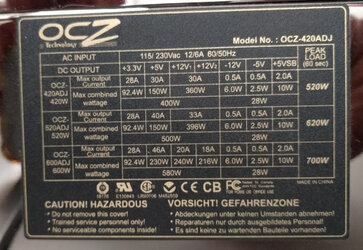- Joined
- Jan 27, 2011
- Location
- Beautiful Sunny Winfield
Old stuff. PSU dates to 2004. Line item description from Newegg is "OCZ PowerStream OCZ420ADJ 420W ATX, BTX, SATA, P4 and EPS12V Power Supply" but the product page no longer exists. It looks like this one: https://www.newegg.com/Product/Product.aspx?Item=N82E16817104152
Markings on the PSU are:

Motherboard is the Supermicro 8XSIL (Intel 1156 socket) Releae date for the manual is August 20, 2013. (http://www.supermicro.com/products/motherboard/Xeon3000/3400/X8SIL.cfm?IPMI=N)
The manual states "It is strongly recommended that you use a high quality power supply that meets ATX12V standard power supply Specification 1.1 or above." According to Wikipedia ATX12V 1.1 came out on 2000 so I would think that this PSU would meet that standard.
I get a green power LED on the motherboard and couple spins on the CPU fan but no further activity.
Thanks!
Edit: I swappd in a more recent PSU - a PC Power and Cooling S61EPS (https://www.newegg.com/Product/Product.aspx?Item=N82E16817703005) and it does work. Now my question is if the other PSU is malfunctioning or is simply not compatible with this motherboard. This PSU was purchased mid 2007 so it is not as old.
Markings on the PSU are:

Motherboard is the Supermicro 8XSIL (Intel 1156 socket) Releae date for the manual is August 20, 2013. (http://www.supermicro.com/products/motherboard/Xeon3000/3400/X8SIL.cfm?IPMI=N)
The manual states "It is strongly recommended that you use a high quality power supply that meets ATX12V standard power supply Specification 1.1 or above." According to Wikipedia ATX12V 1.1 came out on 2000 so I would think that this PSU would meet that standard.
I get a green power LED on the motherboard and couple spins on the CPU fan but no further activity.
Thanks!
Edit: I swappd in a more recent PSU - a PC Power and Cooling S61EPS (https://www.newegg.com/Product/Product.aspx?Item=N82E16817703005) and it does work. Now my question is if the other PSU is malfunctioning or is simply not compatible with this motherboard. This PSU was purchased mid 2007 so it is not as old.
Last edited: